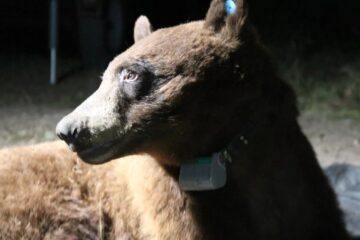Ed Davis Park Trail: A green uprising
Volunteer Jim Nowatzki goes mano a mano with overgrown trails at Ed Davis Park. But with singed canyons recovering from the 2003 blazes, he wouldn’t have it any other way.
Source of this article – Los Angeles Times, May 3, 2005.
By Hugo Martín, Times Staff Writer
On a warm, blue-sky morning, Jim Nowatzki surveys a meadow covered in waist-high wild mustard and grass at the base of Towsley Canyon in the Santa Susana Mountains. Though the blooms make his job tougher, he’s not complaining.

KEEPING IT ALL IN CHECK: Jim Nowatski has witnessed the recovery of Towsley Canyon that was left scarred and barren after wildfires swept through two years ago.
“It’s amazing how it has come back from the fires,” says the retired engineer from Northridge, who spends his free time maintaining the canyon trails in Ed Davis Park in Santa Clarita.
He remembers the October 2003 wildfires that blackened much of the rugged canyon, leaving it looking like the dark side of the moon.Nowatzki warns me that the 2 1/2 -hour hike is a tough climb with big visual payoffs. He hands me a fanny pack loaded with two bottles of chilled water, and we start up the trail.He’s 65 years old, gray-haired and mannerly, but launches ahead with the energy of a first-grader on a Krispy Kreme high. I scramble to keep up.
The first mile rises gently along Towsley Creek, a small rippling stream that winds along the base of the canyon. In a few spots, we bound over the water, hopping on turtle-shaped rocks. Purple sage, lavender-colored lupine and prickly milkweed thistle line the broad dirt trail. An occasional monkey flower, the color of orange sherbet, pokes out from among the undergrowth.
After 20 minutes, the hollow roar of traffic on the 5 Freeway is swallowed by calming canyon sounds: water trickling, birds bickering, leaves and branches rustling.
A mile and a half into the hike we come to the Narrows, where the trail and the creek squeeze through a 20-foot-wide gap between 200-foot canyon walls. From the bottom of this crevice we examine the gray, tan and brown bands of rock, sand and dirt that were thrust up millions of years ago to form these nearly vertical slabs.
There’s also a bit of black gold here. Native Tataviam Indians once drew tar from the canyon to waterproof their baskets. Hundreds of years later, oil companies built roads and pumped out the crude.
The black goo continues to bubble up, emitting an acrid smell that bites through the aroma of lupine, mustard and wild grass.
 Just past the Narrows, we come to eight sharp switchbacks and begin a 1,000-foot climb to the ridge and the wide-angle vistas of the Santa Clarita Valley.
Just past the Narrows, we come to eight sharp switchbacks and begin a 1,000-foot climb to the ridge and the wide-angle vistas of the Santa Clarita Valley.
From the top we spot two red-shouldered hawks, coasting lazily on a breeze. To the south is a stand of Douglas fir, a rare sight in semiarid Southern California.
But the view of the valley — bisected by the 5 Freeway and beset with rows of tract housing — does not compare to the scene along the summit trail. Purple sage, lavender lupine, violet blue dicks and the last of the flowering chocolate lilies create a painterly image. The air pulsates with bees and butterflies.
At several points along the switchbacks, we are swallowed up by the green and yellow mustard that creates a flowering canopy above. It feels as if we’re in the middle of a flower riot, trying to push our way clear.
Part of the work Nowatzki does twice a week involves cutting back the greenery. But this year he’s clearly outmatched by the green uprising ignited by winter’s near-record rains.
He shows me several spots along the trail that he trimmed just a week ago with a gas-powered weed wacker: New growth has already begun to poke up.
We descend from the ridge and back toward the park entrance along Wiley Canyon and stop to examine a bubbling spa-size pool of oil where kids like to poke at the ooze with sticks.Some of the oil has seeped into an ankle-deep creek that flows down Wiley Canyon, giving the water a black veneer.Back at the parking lot, Nowatzki tells me he hopes to recruit more volunteers to keep the trails in check.
Considering the park’s ferocious revival, he’ll need them.


